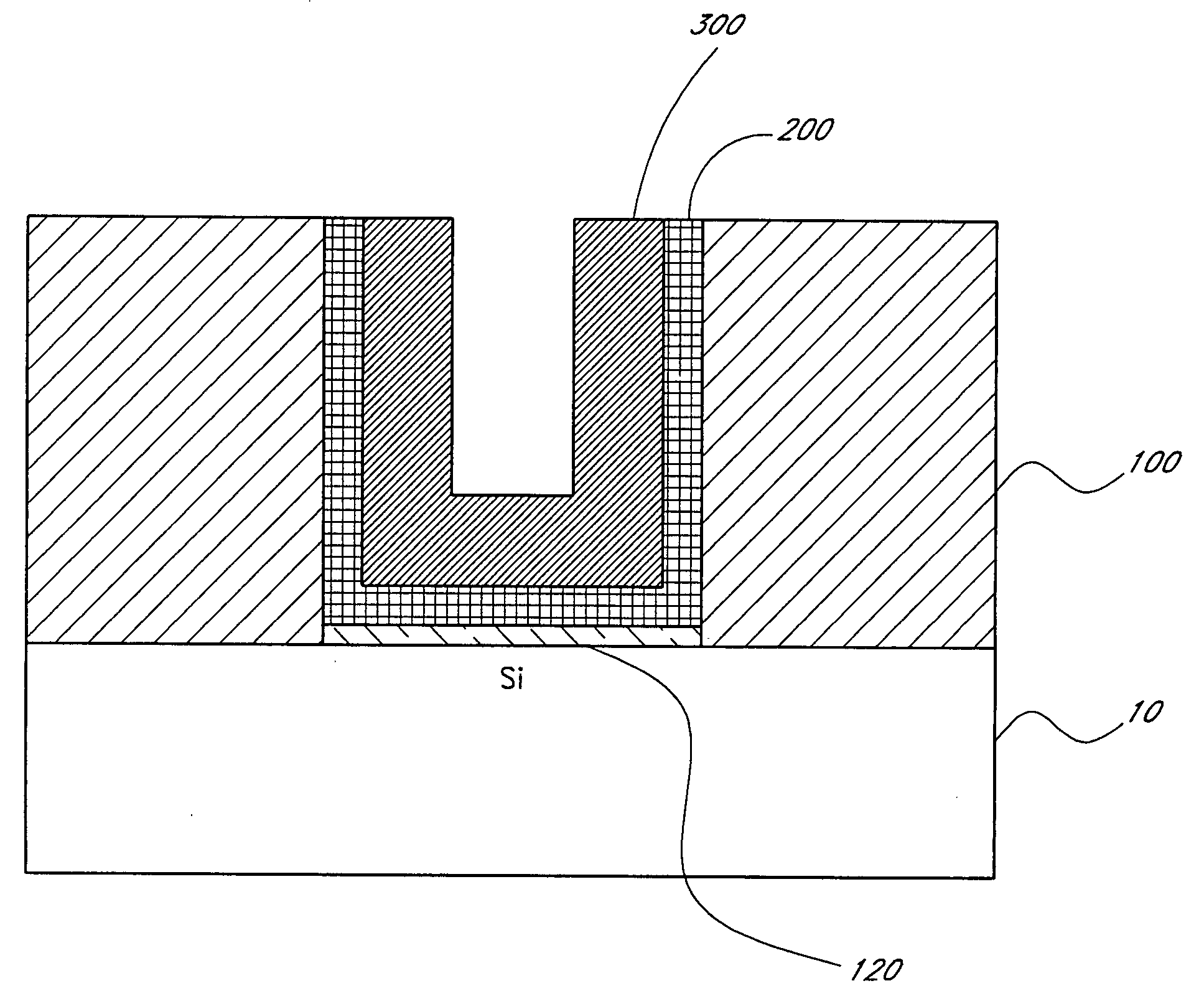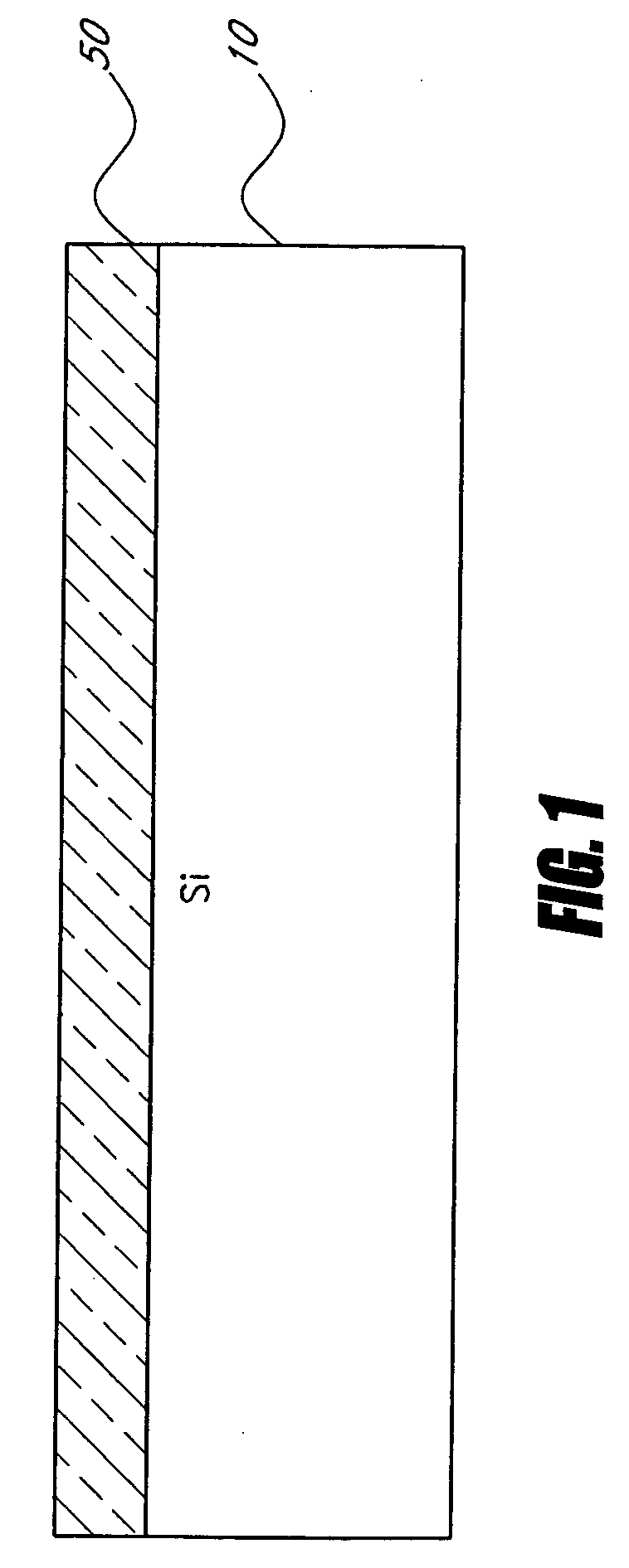Enhanced deposition of noble metals
- Summary
- Abstract
- Description
- Claims
- Application Information
AI Technical Summary
Benefits of technology
Problems solved by technology
Method used
Image
Examples
example 1
[0105] Ruthenium thin films were deposited on 300 mm wafers from alternating pulses of bis(ethylcyclopentadienyl)ruthenium (Ru(EtCp)2) and oxygen (O2) at a temperature of about 370° C. No halide treatment was employed.
[0106] The pulse length of the evaporated ruthenium precursor was about 0.7 seconds and was followed by a purge with an inert gas that lasted from about 2 seconds. The pulse length of the oxygen-containing reactant was about 2 seconds and the purge thereafter was about 2 seconds.
[0107] Ruthenium was found to grow using this process on TaN, Al2O3, Ta and HfO2 surfaces. The typical growth rate is about from 0.5 to 0.9 Å / cycle on these surfaces, not counting incubation time. The incubation time for Ru growth was found to be about 50-100 cycles on TaN, 50-100 cycles on Al2O3, about 50 cycles on Ta and virtually zero on HfO2.
[0108] However, even 450 cycles of the same Ru process did not produce a measurable and conductive film on a thermal silicon oxide surface produced ...
example 2
[0110] Ruthenium thin films were deposited from alternating pulses of bis(ethylcyclopentadienyl)ruthenium (Ru(EtCp)2) and oxygen (O2) on a pure SiO2 surface and on a SiO2 surface modified with HfCl4. The reactions were carried out at 260° C. to 360° C. On the pure SiO2 surface, some color began to be seen at 360° C. The low intensity of the color and the fact that the whole SiO2 surface was not covered with the color indicated that only some weak reaction of the ruthenium precursor and the SiO2 surface was occurring at this temperature.
[0111] At the lower temperature (260° C.) the SiO2 surface remained completely white, indicating that no ruthenium growth was taking place. These results are consistent with those of Example 1 and indicate that Ru(EtCp)2 is not reactive with a pure silicon surface at temperatures below about 360° C.
[0112] These results confirm that Ru(EtCp)2 is highly unreactive towards a pure SiO2 surface and explain the long incubation time that has been observed ...
example 3
[0114] Bis(ethylcyclopentadienyl)ruthenium (Ru(EtCp)2) was used to deposit ruthenium by ALD on pure, untreated Al2O3 and on Al2O3 that had been treated with HfCl4 or AlCl3.
[0115] The ALD reactions were carried out at both 260° C. and 360° C. At the higher temperature, only some non-uniform brownish color was observed on the untreated surface. At the lower temperature, the untreated Al2O3 surface remained unchanged by the deposition process.
[0116] On both the HfCl4 and AlCl3 treated surfaces, a uniform brown film was obtained at both temperatures. At the lower temperature the film was smoother than at the higher temperature.
PUM
| Property | Measurement | Unit |
|---|---|---|
| Temperature | aaaaa | aaaaa |
| Temperature | aaaaa | aaaaa |
| Temperature | aaaaa | aaaaa |
Abstract
Description
Claims
Application Information
 Login to View More
Login to View More - R&D
- Intellectual Property
- Life Sciences
- Materials
- Tech Scout
- Unparalleled Data Quality
- Higher Quality Content
- 60% Fewer Hallucinations
Browse by: Latest US Patents, China's latest patents, Technical Efficacy Thesaurus, Application Domain, Technology Topic, Popular Technical Reports.
© 2025 PatSnap. All rights reserved.Legal|Privacy policy|Modern Slavery Act Transparency Statement|Sitemap|About US| Contact US: help@patsnap.com



